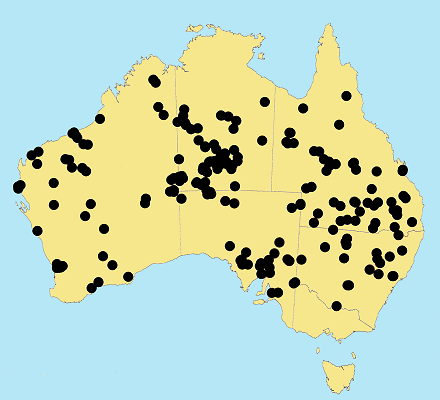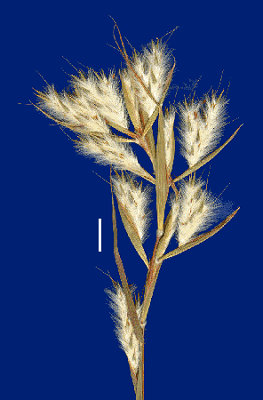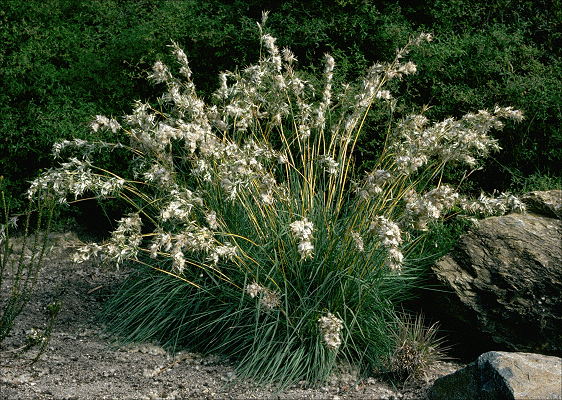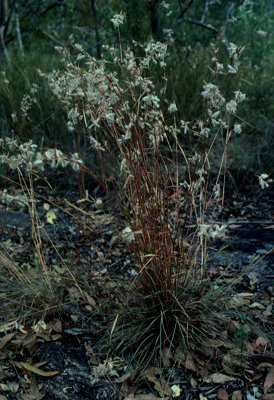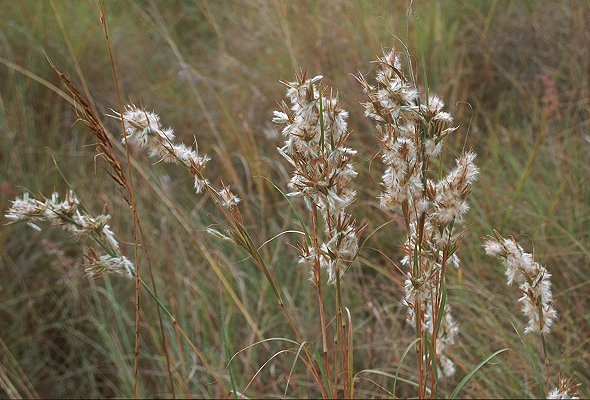Cymbopogon obtectus S. T. Blake. Univ.
Queensland Dept. Biol. Pap 2(3): 55 (1944).
Classification.
(GPWG 2001) : Subfamily Panicoideae. Andropogoneae.
Type of Basionym or
Protologue Information: HT: S.T. Blake 6517, 29 Jun 1934, Australia:
Queensland: Gregory North District: Woodstock, west of Winton (BRI-010799; IT:
K, US-1865510).
Key references
(books and floras): [1981] M.Lazarides in J.Jessop (ed)., Flora of
Central Australia (489), [2002] D.Sharp & B.K.Simon, AusGrass,
Grasses of Australia, [2006] J.Jessop, G.R.M.Dashorst, F.M.James, Grasses
of South Australia (514), [2008] S.W.L.Jacobs, R.D.B.Walley &
D.J.B.Wheeler, Grasses of New South Wales (191).
Illustrations:
[2006] J.Jessop, G.R.M.Dashorst, F.M.James, Grasses of South Australia (515, Fig. 441), [2008] S.W.L.Jacobs,
R.D.B.Whalley & D.J.B.Wheeler, Grasses of New South Wales, 4th edn
(191).
Habit.
Perennial. Culms 50–100 cm tall, 1–2 -noded. Mid-culm nodes glabrous or
pubescent. Ligule an eciliate membrane, 3–5 mm long. Leaf-blades flat or
conduplicate or revolute, 15–35 cm long, 1–3 mm wide.
Inflorescence.
Inflorescence compound, composed of rames. Central inflorescence axis 7–25 cm
long. Rhachis fragile at the nodes.
Spikelets.
Spikelets sessile, 1 in the cluster. Companion spikelets pedicelled, 1 in the
cluster. Basal sterile spikelets well-developed, 2 in number (lower raceme).
Companion spikelets developed, comprising 2 unequal glumes without lemmas or
containing empty lemmas, 3–5 mm long. Companion spikelet glumes muticous.
Fertile spikelets 2-flowered, the lower floret barren (rarely male), the upper
fertile, comprising 1 basal sterile florets, comprising 1 fertile floret(s),
without rachilla extension, lanceolate or elliptic or oblong or obovate, dorsally
compressed, 5–6.4 mm long.
Glumes. Glumes
dissimilar, firmer than fertile lemma. Lower glume lanceolate, chartaceous,
keeled, 2-keeled, wingless, 0–5 -nerved. Upper glume lanceolate, keeled,
1-keeled, 5–7 -nerved. Florets. Basal sterile florets 1, barren, without
significant palea. Lemma of lower sterile floret hyaline, 2–3 -nerved.
Fertile lemma 3.6–4.5
mm long, without keel, 1–3 -nerved. Lemma apex lobed, awned, 1 -awned. Median
(principal) awn from a sinus, 6–8 mm long overall, without a column or with a
straight or slightly twisted column. Palea absent. Anthers 3.
Continental
Distribution: Australasia.
Australian
Distribution: Western Australia, Northern Territory, South Australia,
Queensland, New South Wales, Victoria.
Western Australia:
Canning, Giles, Fortescue, Carnarvon. Irwin, Drummond, Coolgardie. Northern
Territory: Victoria River, Barkly Tableland, Central Australia North,
Central Australia South. South Australia: North-western, Lake Eyre,
Gairdner-Torrens Basin, Eyre Peninsula, Northern Lofty, Murray, Southern Lofty.
Queensland: Burke, Burnett, Darling Downs, Gregory North, Maranoa,
Mitchell, Moreton, Port Curtis, South Kennedy, Warrego, Cook, North Kennedy,
Leichhardt, Gregory South. New South Wales: North Coast, Northern
Tablelands, North-Western Slopes, Central-Western Slopes, North-Western Plains,
North Far Western Plains. Victoria: Murray Mallee, Riverina.
Notes.
A species occurring in drier regions of Australia. Flowers all year.
